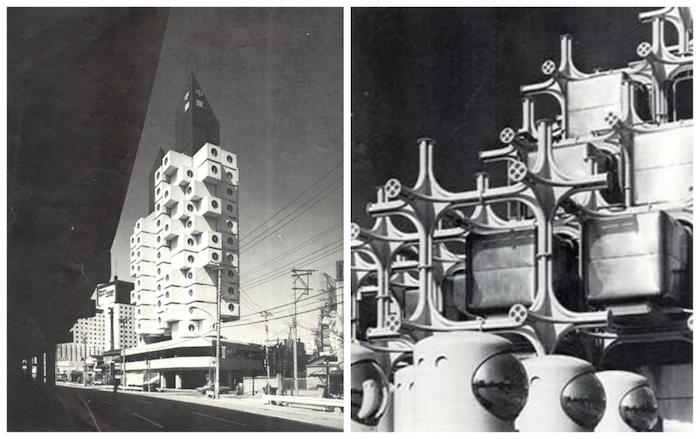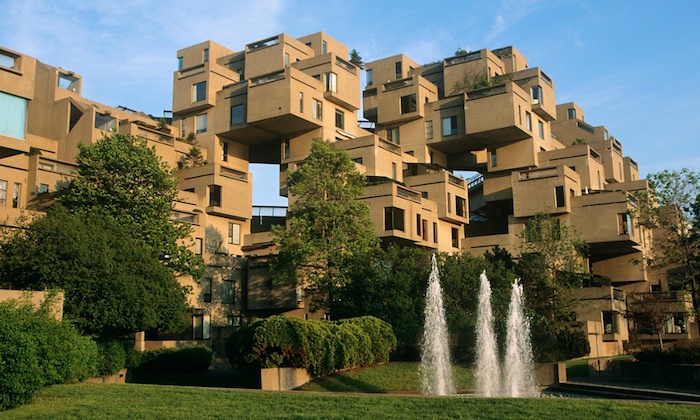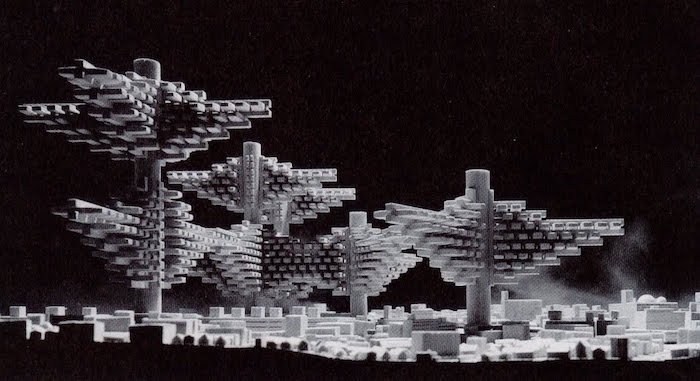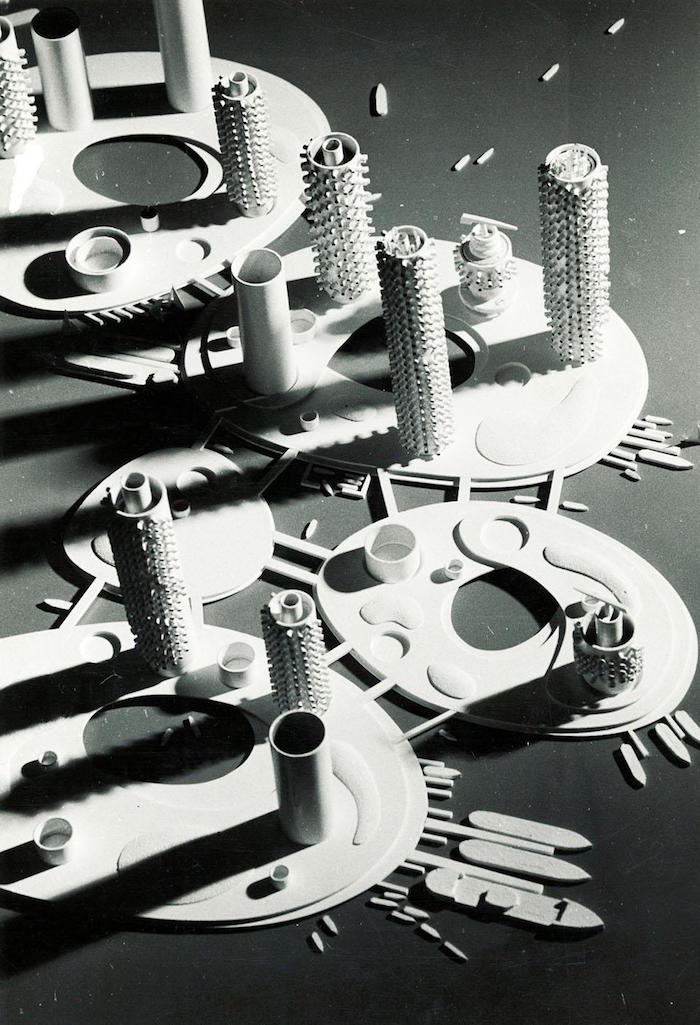Spatial Bodies | AUJIK
Keywords: 3d animation, ada o'higgins, Architecture, AUJIK, environment, metabolism, video art
When a city comes alive.
Spatial Bodies imagines the Osaka urban landscape coming alive. Using 3D meshes, AUJIK distorts buildings into self-replicating organisms, creating a jungle of concrete chaos that recalls both the fluid movements of nature and the intimidating possibility of a robotic future. Ada O’Higgins catches up with Kyoto based esoteric sect AUJIK to discuss fashion and architecture, the future of cities, and what a ‘wiggly’ world means.
Ada O’Higgins: I read that your work is inspired by Gunkan and metabolism architecture. How feasible were some of the concepts proposed by these groups, for instance marine cities or cities connected by highways in the sky?
AUJIK: The metabolism architectural movement that emerged in Japan in the early 60’s was influenced by brutalism and Le Corbusier’s ideas, but with a much more flexible and organic approach. Ideologically they were also inspired by Marxism and other avant-garde thinkers of the time.
For Spatial Bodies I was at first very intrigued by Hashima Island/Gunkan-jima, which is an abandoned, former coal mining facility on a constructed island outside of Nagasaki. Gunkan means battleship in Japanese––indeed this island made of concrete clusters resembles a battleground. However, after the Hashima island population peaked at ca 5000 in the 70s, inhabitants started to move out of Hashima. It’s now largely abandoned and has acquired a dystopian, almost post-apocalyptic aura similar to Pripyat near Chernobyl. For some time, I was thinking about making work inspired by this neglected, forgotten atmosphere. But when I discovered metabolism I became very fascinated with their approach, which is a bit similar to the Dada and surrealist movements in it’s utopian, sometimes absurd visions for the future.
Kiyonori Kikutake – one of the most prolific members of the Metabolism group – is especially moving. Many of his projects were too outlandish to be executed. There were also often political and social agendas to his visions, for instance his concept for the Marine city. He conceived of a city built on pontoons drifting in the sea, with a population of half a million living in giant concrete cylinders. Kikutake was very concerned with the disproportion between Asia’s growing population and its level of agricultural productivity. He believed the sea could be converted into a habitable environment thanks to new architectural concepts and construction methods, envisaged ways to cultivate and harvest the sea in an efficient and environmentally sustainable way. To him, the architectural structures and landscapes of the future would grow organically, like a living organism.
Another vision he and his companion Kisho Kurokawa proposed was that of artificial land. The idea was to build cities based on flexible modules that could easily be reconstructed and expanded and thus be better prepared against typhoons, tsunamis and earthquakes. I think it will be possible to and even necessary to consider some of the these fantastical concepts someday. For the moment, the complications and monetary issues that come with building a city from scratch are too great (though it’s been done lately in the Middle East as well as in Songdo in South Korea.) Perhaps it will become more relevant due to global warming, or if we are one day able to colonize other planets.

AO: I wonder if mediums like fashion, that are present in people’s daily lives, can be more effective mediums for inspiring people and influencing collective consciousness’ than other forms of cultural production. Like fashion, architecture is an unavoidable part of everyone’s landscape, whether it recalls the comfort of a home or the trappings of sleek corporate oppression. Can contemporary architecture inspire new horizons of thought, or is it still an elitist medium that benefits the wealthy and only serves cities in their performance of grandeur and progressiveness?
AUJIK: I suppose fashion is truly the most accessible and effective medium since it’s such a common way for people from an early age to express their personality, status, opinions etc. It’s relatively simple to build or change one’s identity through fashion. People easily adapt different styles so that the way someone dresses becomes a way to map who they are on various levels. I mean perhaps an older person can’t distinguish punk fashion from visual Kei, or smaller nuances like a death metal fan from a sleaze rocker. But at least it gives some impression of who the person is or striving to be. Fashion and the social patterns it inspires easily creates a collective consciousness as well as a social capital. The same goes for contemporary architecture even if it’s bit more complicated for most people to invest in as social capital, than let’s say, a pair of jeans. But I still think it can be more than a medium that just serves the simple purposes of dwelling and status affirmation. From where I see it used to be more about dwelling than status. Like in Sweden, where’s there’s an enormous lack of dwelling, it’s very unusual that they build regular apartments for people with an average wage nowadays. Instead there’s a big market for fancy apartment at a waterfront location and with all sorts of facilities. This creates a segregation which is maleficent. There’s obviously more distinct examples of this in countries like South Africa and Brazil. Then there’s cities like Dubai and Doha that seems more like monuments of grandeur than cities customized for people. I wish there could be more utopian visions like Lucio Costa and Oscar Niemeyer’s imaginations with Brasilia and Jacque Fresco’s Venus project. Something that goes beyond just design and construction.

AO: I saw you were inspired by Alan Watt’s concept of a ‘wiggly’ world. Do you see Spatial Bodies as a visualization of this concept of interconnectedness between the distinct fragments that are perceptible at any given moment by the human mind?
AUJIK: Yes, the idea that everything is interconnected even though we usually cannot perceive it that way with our eyes. There are no separate things or separate events, but we still are compelled to structure and organize the physical world, which in its nature is actually ‘wiggly’. This concept is similar to some of the fundamental ideas of Zen-Buddhism as well as string theory and other post-modern philosophical theories.
Regarding architecture, I consider Japanese cities to be quite wiggly. I grew up in Sweden where most apartment blocks are built according to the Soviet model, like an avenue of concrete boxes. Living in Japan, I enjoy this variation of architecture bodies and the contrast and diversity it creates.

AO: How do see Daisuke‘s music interacting and relating to the imagery in the film?
AUJIK: Daisuke’s soundscape reminds me a bit of earlier Japanese electronic pioneers such as Isao Tomita, Ryuichi Sakamoto and Nobukazu Takemura, which possess a suggestive feeling that I’m really fond of. Initially we were talking about more of an ambient sound instead of a melody. I mentioned the anime Ghost in the Shell and how the music creates this fantastic atmosphere in the city panorama scenes. My only wish was that he’d make something without beats and that had a melancholic, vulnerable vibe to it. It sounds a bit like a lullaby which I think resonate really well with the image.
AO: Can you explain more in detail the motion tracking process you used?
AUJIK: It was motion tracked with a software called Syntheyes by Andersson Technologies that I’ve used for most of my videos. Nowadays it’s quite an easy task to motion track video footage with lots of automatic settings that create a script you import to your 3D software, after which you can add 3D meshes. This video was a bit more difficult and required a lot of patience and time. To get a sense of the shapes and positions I had to manually add an enormous amount of trackers so I could extend the real buildings with 3D meshes.
AO: You could say contemporary art relies heavily on a spirit of animism or anthropomorphism applied to art objects––imbuing them with spiritual powers that in turn can be translated to monetary value. What if we could, in a similar spirit, treat the different elements of the urban landscape as sacred structures to be respected?
AUJIK: Yes, or it might be more like the opposite also. Once an art piece has been injected with a monetary value it’ll gain a spiritual one; a sort of divine status. Before it’s been monetary labeled its usually of no interest for people in general.
I think many structures have a sacred status. Especially those that have been around since a city was built, and became landmark and artifacts by its surroundings. Such as all the great skyscrapers at Manhattan, like Empire State Building and Chrysler Building. In Japan there’s often Shinto shrines near massive buildings which I suppose give them an animistic and sacred label. In Japan it’s also quite common to have objects – from buildings down to smart phones – blessed by a Shinto priest. Lately I’ve notice it became popular with drones, which is something I’ve been considering.

AO: How has drone filming impacted your most recent work?
AUJIK: When I started using 3D software about ten years ago, I was very fascinated by the 3D/Virtual camera in the software and the endless possibilities with camera motion work. Like how it could move by the X,Y,Z axes without any limitations and being able to change lens- FOV (Field of View) and add Depth of Field. For the first years I mainly made crude landscapes with simple objects in which the camera could float around. It was very amusing to mimic Kubrick and Tarkovsky’s camera work. Further on I started filming with a DSLR camera attached to a Steadicam and using motion tracking. I suppose that’s the best option if you’re on a strained budget and trying to achieve some sort of film like quality, even though the camera work is limited to where your body is and it’s hard to accomplish perfectly steady shot. I made about 15 videos with that equipment until I started filming with a drone this year. By using a drone it’s like going back to the virtual 3D software camera again, except you use it in the real world. It’s really remarkable when you learn to control it and it become a nearly unlimited extension of the arm.

AO: Can you elaborate on the influence of Lee Guō, the Taiwanese architect, on Spatial Bodies?
AUJIK: I discovered him a few years ago while reading about Taiwanese metabolism architecture from the 60’s. Lee Guō was very inspired by the Japanese metabolism movement and was commissioned by the Chinese vice president Chen Cheng to build a hospital in Taichung city. His only requirement for the project was to build something as durable as possible.
The construction process ended up being a disaster that cost 18 people their lives and took 7 years to complete. When it was completed in 1968 the Chinese government immediately sealed it and tore it down. All blue prints and photos were confiscated and Lee Guō was sentenced to 3 years in prison and then deported to Manchuria. Since there are no photos of the building, it’s very intriguing to speculate on what it may have looked like. In interviews with some of the construction workers and other people involved, they say it was completely inhuman, with no construction plan whatsoever, and no windows or entrances. The only entrance was through a tunnel that led to a shaft in the middle of the building and then to each floor. One person described it as a kid who goes bananas with lego blocks, but has no sense of physics, aesthetics or functionality.
During these 7 years Lee Guō wrote a manifesto which was later found in 1995. Even though I haven’t read it myself – only an article published by a Japanese architecture student– it seemed like the most crazy approach not only to architecture, but to society and humans in general. Among other things, Lee Guō claimed that the reason we exist is to construct, maintain and cultivate structures. He regarded architecture as the most refined form of nature and imagined a world in which architecture would become an amalgam of self aware organisms that would have the ability to reproduce themselves thanks to technology. Today, he would probably consider Artificial Intelligence and large scale 3D printing as feasible methods of construction.
